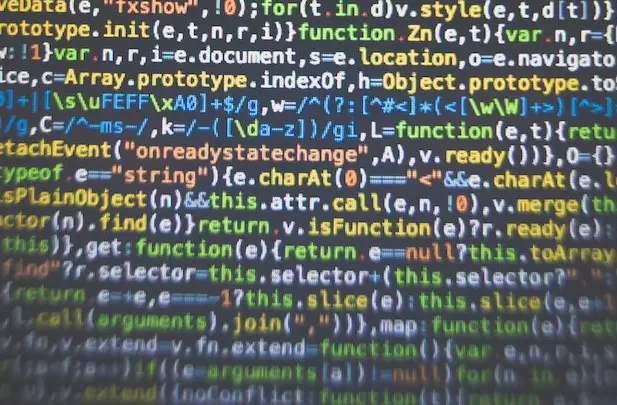Mnemonic codes provide a high level of abstraction for the programmer, allowing them to use symbols or words as instructions rather than having to type out complex commands in order to get a desired result. On the other hand, Machine Code provides precise instructions that can be quickly executed by a computer processor without any further interpretation.
What are mnemonic codes?
(Photo by Gabriel Heinzer on Unsplash )

In the context of computer programming, mnemonic codes are abbreviations or symbols that are used to represent low-level machine code instructions in a way that is easier for programmers to remember and work with. These codes are often used in assembly language programming and allow programmers to write code in a more human-readable form. For example, instead of writing out the binary code for a machine instruction, a programmer can use a mnemonic code such as “ADD” to represent the addition instruction.
What are machine codes?
(Photo By Christiaan Colen on Flickr)

Machine code is a low-level programming language that is used by computers to execute instructions. It consists of binary code that the computer’s processor can understand and execute. Machine code is specific to the computer’s hardware architecture and is written in a format that is difficult for humans to read and understand.
Each instruction in machine code is represented by a sequence of 0s and 1s, which corresponds to a specific operation that the computer is capable of performing, such as adding two numbers together or storing data in memory. Machine code is typically generated by compilers or assemblers, which translate higher-level programming languages into machine code that can be executed by the computer’s processor.
Machine code is sometimes referred to as “binary code” or “object code,” and it is the fundamental language that all other programming languages ultimately compile down to before being executed by the computer.
The difference between mnemonic codes and machine code
Mnemonic codes and machine code are two different things in the context of computer programming.
Mnemonic codes are codes or symbols that are used as memory aids or shortcuts to represent instructions in a more human-readable form. They are often used in assembly language programming and serve as a way for programmers to remember complex sequences of instructions. For example, instead of writing out the binary code for an instruction, a programmer can use a mnemonic code such as “ADD” to represent the addition operation.
Machine code, on the other hand, is the low-level binary code that is directly executed by a computer’s processor. It is specific to the computer’s hardware architecture and consists of a series of 0s and 1s that represent the instructions that the processor is capable of executing. Machine code is written in a format that is difficult for humans to read and understand, and it is typically generated by compilers or assemblers that translate higher-level programming languages into machine code.
Mnemonic codes are used as memory aids for programmers, while machine code is the binary code that a computer executes to carry out specific operations.
How to use mnemonic codes?
Mnemonic codes are a type of code used to represent instructions in a computer program. They are typically made up of a combination of letters and numbers that represent the operation to be performed. For example, the code “ADD” might represent an instruction to add two numbers together, while “MOV” might represent an instruction to move a value from one location to another.
Mnemonic codes are generally easier for humans to read and understand than machine code, which is the native language of computers. However, they must be translated into machine code in order for a computer to be able to execute them. This translation is typically done by a compiler or an assembler.
How to use machine codes?
Machine code is the binary code that a computer’s processor executes to carry out specific operations. Machine code is typically not written directly by humans, but is instead generated by compilers or assemblers that translate higher-level programming languages into machine code that can be executed by the computer.
To use machine code directly, you would need to have a deep understanding of the specific hardware architecture of the computer that you are working with, as machine code is specific to that architecture. You would need to manually write out the series of 0s and 1s that correspond to the specific operations that you want the computer to carry out, and then input that code into the computer’s memory.
However, working directly with machine code is generally not practical or necessary for most programmers or computer users. Higher-level programming languages, such as C++, Python, or Java, provide a more human-readable and user-friendly way to write code that can be compiled or interpreted into machine code that the computer can execute. This allows programmers to write complex programs without needing to understand the low-level details of machine code.
What converts mnemonic code to machine code?
A program called an assembler is used to convert mnemonic code to machine code. An assembler is a type of software that takes the mnemonic code, also known as assembly language, and translates it into the corresponding machine code that can be executed by a computer’s processor.
The assembler reads the mnemonic code line by line and converts each instruction into the corresponding binary code. This binary code is specific to the computer’s hardware architecture, so the same mnemonic code will produce different machine code on different types of computers.
The resulting machine code is typically saved as a binary file that can be loaded into the computer’s memory and executed by the processor. The use of an assembler allows programmers to write programs in a more human-readable format using mnemonic codes, while still being able to take advantage of the speed and efficiency of machine code.
What are machine code instructions?
Machine code instructions are the binary instructions that a computer’s processor can directly execute. Machine code instructions are encoded as sequences of 0s and 1s that correspond to specific operations, such as arithmetic or logical operations, data movement, or branching.
Each machine code instruction consists of two parts: an operation code (opcode) that specifies the operation to be performed, and one or more operands that specify the data or memory locations on which the operation should be performed. The operands can be immediate values, register names, or memory addresses.
Machine code instructions are designed to be executed by a computer’s processor without the need for any additional software or interpretation. They are specific to the computer’s hardware architecture, and different types of processors support different sets of machine code instructions. Programmers can write machine code directly, but it is generally more efficient and convenient to use higher-level programming languages or assembly languages that can be translated into machine code.
Featured Image By – Markus Spiske








